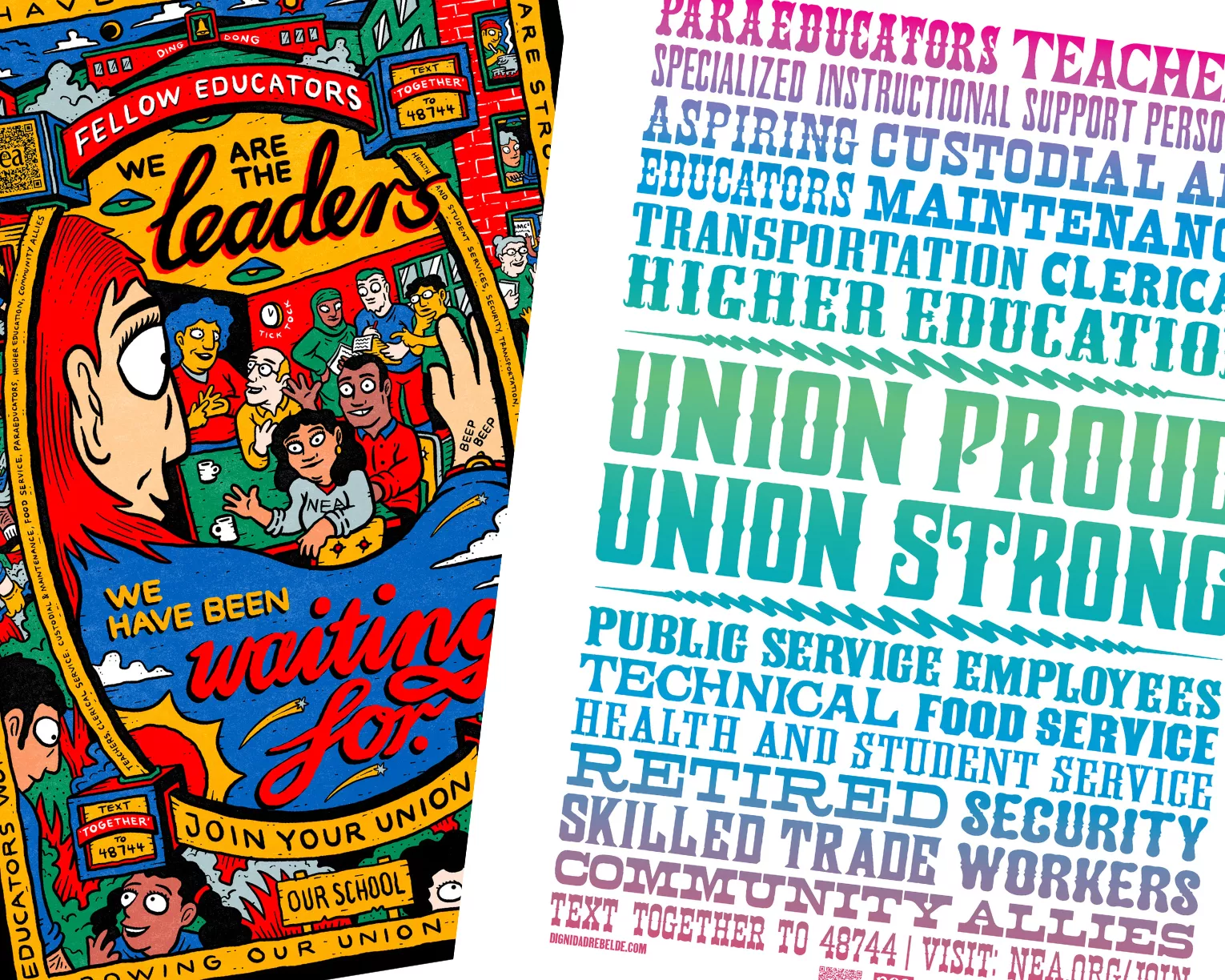How to use this toolkit
Explore our resources for guidance on how to maximize your interaction with potential and new members around new hire events:
Step 1: Gather Information
New educators never forget the friendly face on orientation day who made them feel welcomed. Walking onto a new campus — or into a new profession — is an exciting and overwhelming time. Personal connections matter.
Researchers agree. A joint study with Penn State University and the Jobs with Justice Education Fund suggests that effective orientation programs have an “outsized” and “lasting” impact on the strength of unions. In the longitudinal study conducted in six states, new hires who attended a helpful orientation were more likely to feel a greater commitment to the union and were 35 percent more likely to participate in union activities.
Essentially, a good orientation is a smart and strategic way to connect with new hires, boost membership numbers, and build a foundation for later activism. On the flip side, an unhelpful orientation, or one thrown together at the last minute (think typos, old handouts, and unprepared presenters), can cast doubt about the union and make it even harder to recruit new members.
This guide offers step-by-step planning and some research-based best practices for putting together, a successful orientation that sets the stage for growing and strengthening the union.
Step 1: Gather Information on New Hire Events and Potential Members
First, you will want to try to learn about upcoming events and who the new hires are. This will help you to allocate member organizers and staff, decide if you need additional events, and plan one-on-one outreach.
Gain Access to New Hire Orientations and Events
Here are some tips for successful engagement with new hire orientations, whether or not you are invited to official school events:
- Work with your administration. Ask for time on the administration’s agenda to give a presentation. If the employer won’t make space, find a way to show up anyway — tabling or greeting people outside, etc. Don’t forget department new hire events.
- Buy some time with lunch. Some employers give more time to the Association at the orientation if lunch is provided. Depending on state law, buying lunch could get you exclusive access to potential members for up to an hour.
- Create your own orientation. Create your own union orientation and invite all new hires to join.
- Pass legislation. Some states, like New Hampshire, have successfully legislated guaranteed access to orientations (SB 148).
- Bargain contract language. Strong contract language ensures the Association has contact with new employees before the school year begins.
Build a Potential Member List
Whether or not you are able to access new hire events, it is important to understand who your new hires are. Building a potential member list can help you organize your own events, plan for one-on-one conversations, or to follow up after an orientation.
Ways to start your potential member list:
- Reach out to your administration for a new hire list. Request phone numbers, mailing addresses, email addresses, and work locations.
- Pass legislation. For example, New Jersey has the Workplace Democracy Enhancement Act.
- Make a Freedom of Information Act (FOIA) request. Reach out to your state affiliate for legal writing assistance. If necessary, the NEA Center for Organizing can provide you with sample language as well.
- Negotiate contract language to get the new hire list from your employer. The Association can negotiate language that requires the employer to provide the Association with employee contact information at regular intervals. Ideally, language should also guarantee that the Association can use bulletin boards, staff mailboxes, email, or other means to maintain a consistent and ongoing presence in members’ lives.

Gather Important Information With Year-Round Organizing Cards
Step 2: Prepare for Orientation
Step 2: Prepare for Orientation Day
Now that you have the information you need about upcoming events and this year's new hires, it is time to start preparing for orientation day! A strong game plan for the day will help you approach, recruit, and follow up with each potential new member.
- Choose diverse member organizers. Select a positive, upbeat, and diverse group of member organizers in terms of race, gender, age, and job category who know how to talk about the value of union membership from personal experience. Recruit as many early career educators as possible to share their commitment to the union. Potential members need to hear from them. Consider inviting multiple or diverse presenters to join the president for the presentation.
- Train member organizers and then give them a job to do. Bring in enough member organizers to have one-on-one conversations with every potential member (about a 1-to-10 ratio). Whether it’s presenting at the front of the room, welcoming people at the door, or sitting at a specific table to talk to the potential members at that table, give member organizers a specific job to do.
- Prepare a Welcome Kit. Develop a high-quality, polished kit that includes a welcome letter (example below), a membership application, an NEA Year-Round Organizing card, contact information for local leaders and affiliate staff, your union publication, and a calendar of upcoming union-sponsored professional learning opportunities.
Step 3: Host Your Event
Step 3: Host Your Orientation Program
Whether you are speaking at a school-sponsored event or hosting your own program, you will want to make sure to use your time to share key points about the union and why new hires should become a member. Remember, this is your first impression so focus on being engaging, inspiring, and helpful!
Some items to incorporate when building your agenda:
- Introduce your union and its mission.
- Provide context for members to understand their relationship to the local, state, and national Associations.
- Talk about the power of collective action and share recent successes.
- Explain key pieces of your collective bargaining agreement: salary schedule, leaves (including medical, personal), health and retirement benefits, work day, safe working conditions, recent gains, etc.
- Talk about how to deal with issues at work, i.e. when to call the Association.
- Highlight opportunities for professional growth through the Association.
- Ask them to become a member.
- Invite members to get involved outside the workplace.
- Allow time for questions in small groups at tables.
- Provide breakfast/lunch hosted by the Association.
Note: Use “we” and “our union” when speaking about the Association to emphasize that we’re all in this together.

Ask 100% of New Hires to Join the Union
Step 4: Follow Up
Step 4: Follow Up After Orientation
New Hire Orientations are only your first impression, they should not be your ONLY impression. Make sure to create a plan for following up with new hires who attended your event and to engage with all new hires throughout the year.
Debrief and Immediate Follow Up
Debrief with your member organizers. What went well? Who were your potential leaders? How can you improve next time? What themes came up during conversations? What are the next steps? For reps struggling with recruitment, consider a follow-up training or support from some of your stronger organizers, e.g., pairing up to do office visits or off-campus meetings together.
After your debrief, it is time to follow up with attendees! Make sure to accomplish the following to-dos:
- Ask every new hire to join within the first 30 days.
- Provide building reps and member organizers Year-Round Organizing card information to support their one-on-one conversations.
- Plan to visit worksites or departments where there are no building representatives.
- Send a personal letter to each new hire.
Engaging New Hires All Year Long
Engage with new hires, potential members, and current members year-round. A plan for continuous year-round outreach allows local leaders and building reps to initiate one-on-one conversations that establish the Association as a trusted resource.
Here are some ideas to consider when building out your year-round engagement plan:
- Worksite Visits and One-On-Ones: Plan for staff, member organizers, and union reps to engage in worksite visits and one-on-ones so that each educator is being met with regularly. These conversations should focus on listening to their interests and concerns and showing them how they can achieve their goals through the union.
- Programming and Events: Use the information gathered from your Year-Round Organizing cards to understand the top areas of interests for educators at your school/district. Then, plan a series of webinars, trainings, or in-person events based around those topics. For example, if many educators indicated an interest in classroom management strategies, maybe you could host a book club and read different expert books on the topic!
- Issue Organizing: Another way to engage educators is to find a common issue or problem many of them care about and organize around a solution. This not only shows the power of collective action but helps new people get involved. Try launching a school or district-wide survey to identify these types of issues.
- Communications Programs: Whether it is a printed newsletter that you pass out at school or a social media page, it is helpful to have a calendar to ensure that there is consistent communications going out to educators. Make sure to include the latest news, upcoming meetings or events, and any union wins.
Check out our Year-Round Organizing resources for more tips and strategies!
Organizing Resources at Your Fingertips


